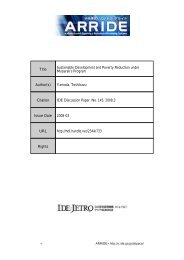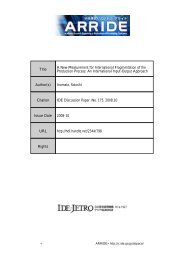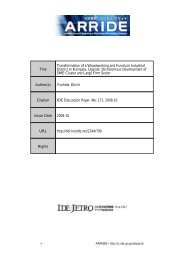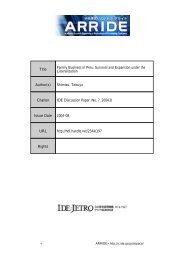Title Financing Small and Medium Enterprises in Myanmar Author(s ...
Title Financing Small and Medium Enterprises in Myanmar Author(s ...
Title Financing Small and Medium Enterprises in Myanmar Author(s ...
You also want an ePaper? Increase the reach of your titles
YUMPU automatically turns print PDFs into web optimized ePapers that Google loves.
(gray or black markets) 79 . In Vietnam, <strong>in</strong>formal channels f<strong>in</strong>ance up to 70 percent to 80<br />
percent of SME needs. Among the available sources of f<strong>in</strong>anc<strong>in</strong>g <strong>in</strong> Cambodia, the Lao<br />
PDR, <strong>and</strong> <strong>Myanmar</strong>, the ma<strong>in</strong> channels of fund<strong>in</strong>g consist of family <strong>and</strong> friends as they<br />
are easier to approach. If SMEs borrow from gray markets, they have to pay higher<br />
<strong>in</strong>terest rates—as much as 20 percent per month for loans without collaterals.<br />
With globalization <strong>and</strong> speedy economic <strong>in</strong>tegration, <strong>in</strong>tra- <strong>and</strong> <strong>in</strong>ter-regional<br />
competitions among nations become tighter than ever. In order to sharpen national<br />
competitiveness <strong>in</strong> global market, governments of ASEAN countries rely more on the<br />
competitiveness of their SMEs <strong>in</strong> the private sector even as they cont<strong>in</strong>ue to reduce<br />
their reliance on <strong>in</strong>efficient SMEs. Now these countries have dynamic, export-oriented,<br />
<strong>and</strong> <strong>in</strong>ternationally competitive SMEs. As the ma<strong>in</strong> eng<strong>in</strong>e for economic growth,<br />
ASEAN countries cont<strong>in</strong>ually develop <strong>and</strong> promote their SME sector with various<br />
promotional tools such as strengthen<strong>in</strong>g <strong>in</strong>ter-firm l<strong>in</strong>kages, offer<strong>in</strong>g various k<strong>in</strong>ds of<br />
bus<strong>in</strong>ess development services, improv<strong>in</strong>g technological <strong>in</strong>novativeness, <strong>and</strong><br />
particularly improv<strong>in</strong>g f<strong>in</strong>anc<strong>in</strong>g access. Now, lead<strong>in</strong>g ASEAN countries have adequate<br />
formal sector arrangements for SME f<strong>in</strong>anc<strong>in</strong>g, which are suitable to their f<strong>in</strong>ancial<br />
requirement for each stage of SME development.<br />
In this comparative analysis on <strong>Myanmar</strong> <strong>and</strong> its counterparts <strong>in</strong> the ASEAN<br />
countries, it can be seen that the gap between <strong>Myanmar</strong> <strong>and</strong> other ASEAN countries<br />
especially with ASEAN-6 is too wide <strong>in</strong> the area of SME f<strong>in</strong>anc<strong>in</strong>g. Formal<br />
arrangements for SME f<strong>in</strong>anc<strong>in</strong>g <strong>in</strong> <strong>Myanmar</strong> lag beh<strong>in</strong>d other countries <strong>in</strong> the ASEAN<br />
region, even with<strong>in</strong> CLMV. Inadequate formal sector f<strong>in</strong>anc<strong>in</strong>g sources, together with<br />
other various obstacles, are major impediments to further development <strong>and</strong> growth of<br />
SMEs <strong>in</strong> <strong>Myanmar</strong>. If no appropriate corrective actions <strong>in</strong> this area are done, the gap<br />
between dynamic <strong>and</strong> competitive SMEs <strong>in</strong> other ASEAN countries <strong>and</strong> the traditional<br />
<strong>and</strong> locally focused SMEs <strong>in</strong> <strong>Myanmar</strong> will be further widened <strong>and</strong> affect the national<br />
economies as well.<br />
7.3 Models of SME f<strong>in</strong>anc<strong>in</strong>g <strong>in</strong> Thail<strong>and</strong> <strong>and</strong> Japan<br />
In Asian countries, Japan, Taiwan, <strong>and</strong> South Korea boast of best practice models <strong>in</strong><br />
SME development. With<strong>in</strong> ASEAN, S<strong>in</strong>gapore, Thail<strong>and</strong>, <strong>and</strong> Malaysia also have their<br />
own models <strong>in</strong> promot<strong>in</strong>g SMEs. In the area of f<strong>in</strong>anc<strong>in</strong>g, they provide various channels<br />
<strong>and</strong> sources of funds to cater to the different needs of SMEs <strong>in</strong> their countries. In this<br />
section, Thail<strong>and</strong> <strong>and</strong> Japan models on SMEs f<strong>in</strong>anc<strong>in</strong>g is presented to provide <strong>in</strong>puts<br />
on the efforts to develop a successful SME f<strong>in</strong>anc<strong>in</strong>g program for <strong>Myanmar</strong> <strong>in</strong> the<br />
79 Ibid., p.21




![Title [書評] 廣田義人著『東アジア工作機械工業の技術形成 ... - ARRIDE](https://img.yumpu.com/47139953/1/184x260/title-arride.jpg?quality=85)






